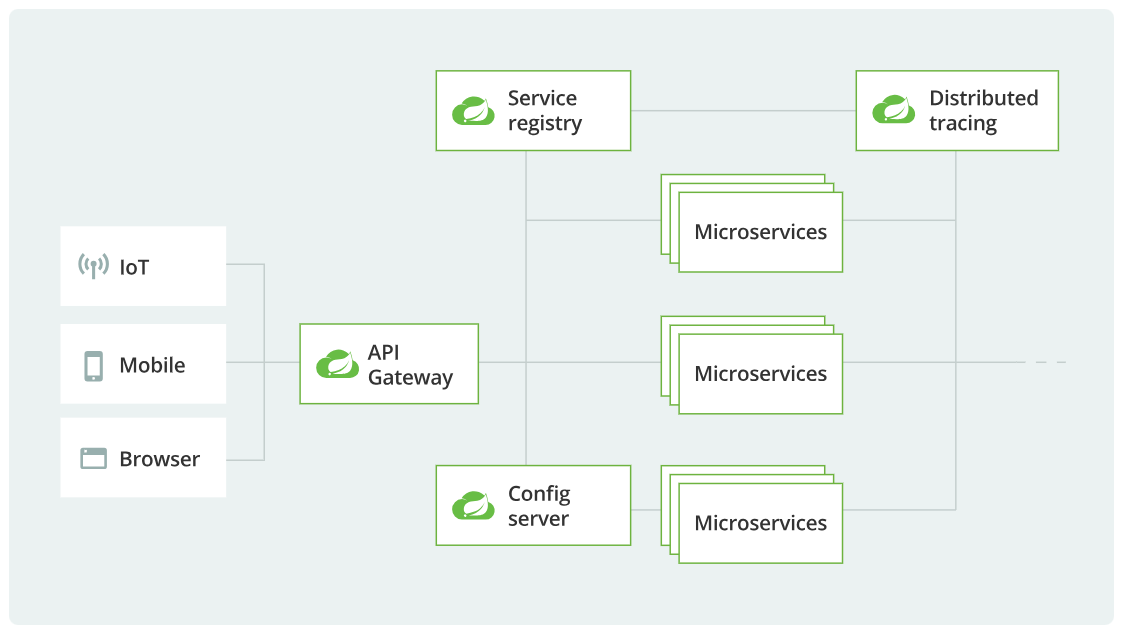🎓 Top 15 Udemy Courses (80-90% Discount): My Udemy Courses - Ramesh Fadatare — All my Udemy courses are real-time and project oriented courses.
▶️ Subscribe to My YouTube Channel (178K+ subscribers): Java Guides on YouTube
▶️ For AI, ChatGPT, Web, Tech, and Generative AI, subscribe to another channel: Ramesh Fadatare on YouTube
In this guide, we’ll explore how Spring Cloud modules can help you design and manage an e-commerce platform, covering everything from service discovery to security, observability, and event-driven architecture.
Before exploring everything about Spring Cloud, let's take a look into how Spring Boot simplifies Microservices development.
How Spring Boot Simplifies Microservices Development
Spring Boot has become the de facto standard for building microservices in Java. It simplifies development by providing:
✅ Embedded Server Model – No need to deploy separately; run microservices as JAR files.
✅ Auto-Configuration – Reduces boilerplate code and simplifies dependency management.
✅ Spring Initializr – Quickstart projects with the necessary dependencies.
✅ Production-Ready Features – Includes metrics, health checks, and monitoring with Spring Boot Actuator.
✅ Integration with Spring Cloud – Extends Spring Boot capabilities for service discovery, configuration management, circuit breakers, and event-driven communication.
With Spring Boot, your microservices can start small and iterate fast, making it ideal for agile development.
1. Why Use Spring Cloud for Microservices?
Spring Cloud provides essential solutions to common microservices challenges:
✅ Service Discovery – Automatic service registration and lookup with Spring Cloud Netflix Eureka.
✅ Centralized Configuration – Manage configurations across multiple services using Spring Cloud Config.
✅ Fault Tolerance – Prevent cascading failures with Resilience4j Circuit Breaker.
✅ Load Balancing – Distribute traffic efficiently using Spring Cloud LoadBalancer.
✅ API Gateway – Secure and route API requests via Spring Cloud Gateway.
✅ Security – Use Spring Security OAuth2 for authentication and authorization.
✅ Observability – Monitor microservices with Micrometer and OpenTelemetry.
✅ Event-Driven Architecture – Enable async communication with Spring Cloud Stream and Kafka.
Spring Cloud architecture highlights
2. E-Commerce Use Case: How Spring Cloud Helps
Imagine you're building an e-commerce platform like Amazon. It consists of multiple microservices:
- User Service – Handles user registration and authentication.
- Product Service – Manages the product catalog.
- Order Service – Processes customer orders.
- Payment Service – Handles payments and transactions.
- Inventory Service – Keeps track of stock availability.
- Notification Service – Sends emails and messages.
Spring Cloud helps connect and manage these services efficiently. Let's dive into each module with an example.
3. Service Discovery with Spring Cloud Netflix Eureka
In a microservices world, services should discover each other dynamically. Eureka Server acts as a central registry.
Setting Up Eureka Server
@SpringBootApplication
@EnableEurekaServer
public class EurekaServerApplication {
public static void main(String[] args) {
SpringApplication.run(EurekaServerApplication.class, args);
}
}4. API Gateway with Spring Cloud Gateway
Instead of exposing each service separately, an API Gateway acts as a single entry point for all client requests.
Configuring Spring Cloud Gateway
spring:
cloud:
gateway:
routes:
- id: product-service
uri: lb://product-service
predicates:
- Path=/products/**5. Centralized Configuration with Spring Cloud Config
Managing configurations across multiple services manually is difficult. Spring Cloud Config allows us to store configurations centrally.
application.yml for Config Server
server:
port: 8888
spring:
cloud:
config:
server:
git:
uri: https://github.com/your-repo/spring-config-repo6. Fault Tolerance with Resilience4j Circuit Breaker
What if Product Service is down? Instead of letting the request fail, we use a circuit breaker to return a fallback response.
Implementing Circuit Breaker in Order Service
@CircuitBreaker(name = "productService", fallbackMethod = "fallbackProducts")
@GetMapping("/products")
public List<String> getProducts() {
throw new RuntimeException("Service Down");
}
public List<String> fallbackProducts(Exception e) {
return List.of("Default Product");
}
If Product Service is unavailable, a default response will be returned instead of an error.
7. Security with Spring Security OAuth2
We can use OAuth2 authentication with JWT (JSON Web Tokens) to protect APIs.
OAuth2 Configuration in Security Service
spring:
security:
oauth2:
resourceserver:
jwt:
issuer-uri: https://auth-server.com
Now, all microservices will validate JWT tokens before allowing access.
8. Observability with Micrometer and OpenTelemetry
Since Spring Cloud Sleuth is now deprecated, the recommended approach is using Micrometer Tracing with OpenTelemetry for distributed tracing.
Enable OpenTelemetry in Services
management:
tracing:
sampling:
probability: 1.0
metrics:
export:
prometheus:
enabled: true
Now, you can track requests flowing through multiple microservices easily!
9. Event-Driven Architecture with Spring Cloud Stream
Modern e-commerce platforms require asynchronous communication between microservices. Spring Cloud Stream simplifies event-driven architecture using message brokers like Kafka and RabbitMQ.
Order Service Publishes an Event to Kafka
@EnableBinding(Source.class)
public class OrderEventPublisher {
private final MessageChannel output;
public OrderEventPublisher(Source source) {
this.output = source.output();
}
public void publishOrderEvent(Order order) {
output.send(MessageBuilder.withPayload(order).build());
}
}
Inventory Service Listens to the Order Event
@EnableBinding(Sink.class)
public class InventoryEventListener {
@StreamListener(Sink.INPUT)
public void handleOrderEvent(Order order) {
System.out.println("Received order: " + order.getId());
}
}
Whenever an order is placed, Inventory Service automatically updates stock levels asynchronously.
10. Best Practices for Spring Cloud Microservices
✔ Use API Gateway – A single entry point for client requests.
✔ Implement Circuit Breakers – Prevent cascading failures.
✔ Enable Centralized Configuration – Manage settings across microservices.
✔ Use OAuth2 Security – Secure API access with JWT tokens.
✔ Monitor & Log – Use Micrometer, OpenTelemetry, and Prometheus for observability.
✔ Adopt Event-Driven Architecture – Use Kafka or RabbitMQ for async messaging.
Final Thoughts
Spring Cloud provides a complete toolkit to simplify microservices architecture. Whether it's service discovery, API routing, security, monitoring, or event-driven architecture, it helps manage microservices efficiently.
🚀 Ready to build scalable microservices? Start experimenting with Spring Cloud today! 🚀




![[NEW] Full-Stack Java Development with Spring Boot 4 & React Build 5 Spring Boot Projects with Java: Line-by-Line Coding](https://img-c.udemycdn.com/course/750x422/5338984_4d3a_5.jpg)











Comments
Post a Comment
Leave Comment